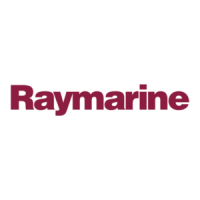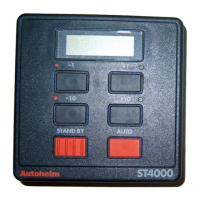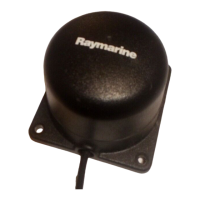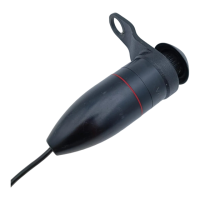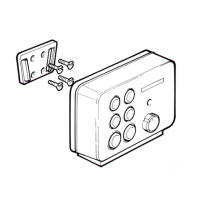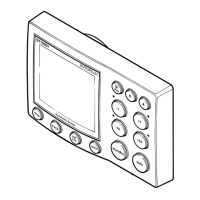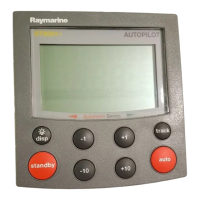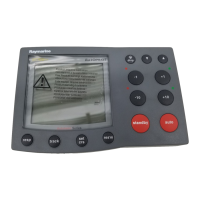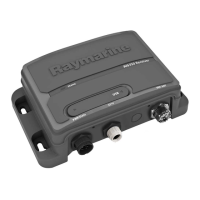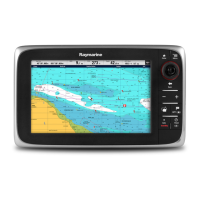Do you have a question about the Raymarine Autohelm ST7000 and is the answer not in the manual?
Explains the fundamental operation of the ST7000 autopilot, including basic principles and key functions.
Details how to engage automatic steering and maintain the current heading or return to previous heading.
Explains how to alter course to port or starboard in increments of 1 and 10 degrees.
Describes how to disengage the autopilot for manual steering, memorizing the previous heading.
Covers how to select track control from Auto and return to automatic steering or previous track heading.
Explains how to adjust the response level for course keeping accuracy.
Details how to adjust the rudder gain level for optimal steering performance.
Details how to switch on and select the desired illumination level for the display.
Describes using the Display pushbutton to cycle through additional information menus.
Shows the main display and navigation displays available in Auto Mode.
Illustrates the main display and navigation displays available in Standby Mode.
Refers to a section detailing navigation displays, likely showing cross track error, bearing, and distance.
Explains the watch alarm function and how it is activated and silenced.
Details specific navigation displays like Cross Track Error, Bearing to Waypoint, and Distance to Waypoint.
Shows the display for the Watch Alarm function, indicating when the alarm is active.
Shows the display for the Waypoint Number, indicating the current target waypoint.
Explains the 4-minute timer, alarm sounds, and how to reset or cancel the Watch Alarm.
Describes the Off Course Alarm, triggered when the vessel deviates significantly from the set heading.
Details the Low Battery Alarm, activated when the supply voltage falls below a critical level.
Covers alarms related to Track Mode, such as no waypoint data or incorrect data format.
Explains the manual override alarm for stern drive installations, occurring after manual steering.
Details the built-in Autotack function for turning the vessel through 100 degrees, explaining its operation in vane mode.
Explains how Wind Trim allows autopilot supervision by apparent wind direction.
Describes the Wind Change Alarm, which sounds if apparent wind angle changes cause significant heading adjustments.
Explains how apparent wind angle and tack sense are displayed when using NMEA or SeaTalk.
Details how to adjust the apparent wind angle using the course change buttons.
Details the three response levels and advises on selecting the most suitable for power consumption and accuracy.
Provides simple points to observe for making full use of Track control, including initial setup and safety checks.
Explains the waypoint alarm and how track control is suspended and resumed during waypoint changes.
Describes how Automatic Trim corrects for trim changes and provides a procedure for large course changes.
Discusses rudder gain selection for steering performance, especially at higher latitudes and with different heading types.
Explains that rudder gain adjustment is usually not necessary for sail yachts after initial sea trials.
Details rudder gain adjustment for powercraft, noting its impact on displacement and planing speeds.
Describes automatic and manual methods for adjusting Rudder Gain based on boat speed for planing craft.
Provides simple checks to find faults if the ST7000 provides unsatisfactory steering performance.
Explains the 'Fail Safe' mechanism and procedures to follow if the drive unit fails to disengage.
Details how to adjust the LCD contrast for optimal legibility based on viewing angle.
Describes the manual override option for stern drive actuators, allowing release of drive during emergencies.
Instructions for checking drive chain tension, alignment, and lubrication for rotary drives.
Guidance on checking hydraulic steering systems for leaks and air, and bleeding if necessary.
Ensuring inter-connecting cable terminals are tight and free from corrosion.
Advice on capping external sockets and using protective spray to prevent corrosion.
Ensuring heavy power supply cable connections are tight and free from corrosion.
Stresses the importance of maintaining a constant watch for obstacles and other vessels while under autopilot.
Recommends recording vessel position using navigation receivers or visual bearings and maintaining a plot.
Highlights the need for all crew members to be familiar with engaging and disengaging the autopilot.
Mandates a crew member near the control unit when searoom is restricted and under autopilot control.
Requires a permanent watch at the steering station for powercraft when the autopilot is engaged at speed.
Initial step in fault finding: verify connections are sound and power connections are tight and corrosion-free.
Verify rudder angle and heading displays for correctness, checking connections to transducers if incorrect.
Identifies likely fault location for sailing yachts with windvane systems if issues occur only in vane mode.
Indicates a high probability of fault in the course computer if an electronic fault occurs.
Indicates a fault in the control unit if the issue is specific to one control unit.
Outlines the warranty terms for product defects apparent within twelve months of purchase.
Details the warranty applicable for product use outside the country of purchase.
Provides information on obtaining prompt and expert attention for any difficulties through service centers.
| Brand | Raymarine |
|---|---|
| Model | Autohelm ST7000 |
| Category | Marine Equipment |
| Language | English |
